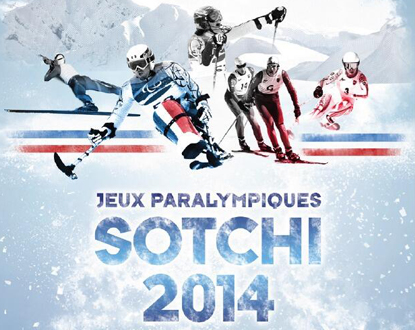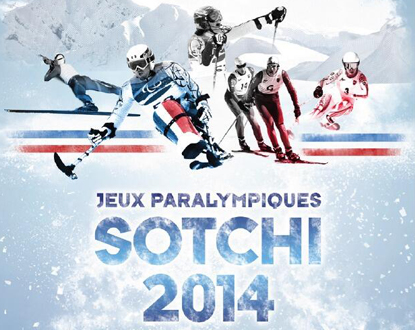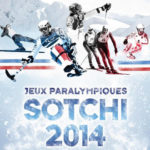The Frenchwoman Cécile Hernandez-Cervellon won silver on Friday in the standing snowboard cross event at the Sochi Paralympic Games.
In the final, the Catalan (registered with the Nice club ANICES) finished 9’88” behind the winner, the Dutchwoman Bibian Mentel-Speee. The American Amy Purdy took the bronze medal. This is the 6th medal for France in Russia, the 3rd silver.

Among the 15 French representatives on the shores of the Black Sea, two come from Nice and will enter the competition as early as tomorrow at 7 am French time. Cécile Hernandez-Cervellon and Patrice Barattero will compete in parasnowboarding and have chances for medals!
Sébastien Filippini, president of A.N.I.C.E.S, gave us a few minutes to talk about his club, the Paralympic Games, and his athletes present there.
Nice Premium: The French Paralympic team consists of 15 participants for these Sochi Games, and 2 of them come from ANICES. As president, this must be a real source of pride for you?
Sébastien Filippini: Yes, it’s a great pride, I’m happy, I’m really thrilled. After the disappointment of London, where Benjamin Lantier (Cycling), who was the first French and second worldwide, wasn’t selected despite being the first French and second worldwide, this is a sweet revenge because it’s not one but two athletes we’re sending to the Games. Patrice Barattero has been with us for several years and has been fighting for over 10 years for prosthetics and to develop his discipline; it’s an achievement for him. As for Cécile Hernandez-Cervellon, who arrived recently, she’s the icing on the cake, she passed her classification and given her level, she was selected.
NP: It’s the first time to see Nice athletes competing at such a level, is it a reward for years of foundational work?
SF: Yes, it’s the first time to have two athletes representing the city of Nice, whether at the Winter or Summer Games. I’m very happy. Regarding the club, I founded it 7 years ago, and a tremendous amount of work has been done. We developed disabled sports properly in Nice. Now we have over 90 members compared to 17 in 2007. There’s been significant progress. Initially, the club was just for Torball (editor’s note: a ball game for the visually impaired), and then we developed in several disciplines like athletics, snowboarding, cycling, etc., and we adapted well.
NP: Concretely, what does ANICES bring to athletes present at the Games? Do you give them a special status due to their Olympic status?
SF: For the athletes, my policy has always been the same, whether you’re an ordinary athlete or a high-level one, it’s the same for everyone, I don’t want any differences. This ensures good group cohesion and mutual understanding. Financially, we handle all the travel—car, train, plane covered by the club. Plus, we provide an allowance for the weekend and pay the competition entry fee if necessary. Anything outside the allowance is unfortunately at the athlete’s expense.
NP: The competition will be broadcast on France 4, which is excellent exposure for the athletes, the disciplines, but also for clubs like yours.
SF: Yes, on France 4 at 7 am, French time. I really thank all the press that has been present with us these past few days and has relayed the information well. It is a great satisfaction to also give a place to Paralympic sports as we do to able-bodied sports. It’s gratifying to see the club in Nice highlighted, but the most important thing is the athletes. It’s also crucial to raise public awareness and show people with disabilities that, for example, even without legs, you can snowboard. No matter what the disability is, there’s always a way to engage in sports. Contrary to what some may think, it’s possible; you just have to want it.
NP: Can you tell us about the preparation of your two athletes?
SF: They have often been at Auron since December, participating in various training camps in Serre-Chevalier and Les 2 Alpes. They underwent specific training, had a coach to fine-tune their physical condition, which is very important because it’s very intense. They maintained optimal lifestyles, and there were competitions: a World Cup leg in the United States, one in Canada, and a European Cup leg in Spain as well. Everything was in place to be in top shape.
NP: What are the sports objectives for Cécile Hernandez-Cervellon and Patrice Barattero? Is a medal within reach?
SF: For Cécile, a medal is possible; she aims for one. She’s stated it openly; it’s important. She knows she has the potential and capabilities. As for the color, we’ll have the answer on Friday, but it’s very much within reach. For Patrice, it’s going to be more challenging. Unfortunately, the categories are not well-suited. Patrice is a femoral amputee (above the knee) competing against those amputated at the foot, who have their entire knee mechanism, which greatly benefits them. He’s well aware internally that it will be tough, but as I told him, in a sports career, you never know, someone might fall, be tired, and maybe you’ll have a great run; you never know!





